Council backtracks on developer-friendly tax plan
A majority of the Austin City Council at a work session Tuesday raised questions or concerns about a proposal to subsidize infrastructure development in the South Central Waterfront District, which runs along the south shore of Lady Bird Lake, including the site of the Austin American-Statesman.
The subsidy deal would pay for amenities like fountains, sculptures, and an amphitheater in the shadow of new luxury high rises in the 118-acre district, as well as utilities and a smarter street grid, according to the vision plan and preliminary project plan approved by the council December 20th.
As previously reported by the Bulldog, the council at that meeting also created a Tax Increment Reinvestment Zone (TIRZ), the financing mechanism for the infrastructure, but delayed a decision on the exact increment of property tax that would go toward development in the district.

Mayor Steve Adler and Council Member Kathie Tovo were the strongest advocates of the subsidy deal when it was discussed in December, with Tovo calling for a March 2nd deadline for setting a tax rate to operationalize the district. “I think we should be scheduled for action,” she said.
But Tovo kicked off the discussion Tuesday with a tone of less urgency and asked staff for more information about alternatives to the TIRZ. She said, “As we’ve talked about the South Central (District) through the years, the TIRZ was a potential funding source—but it wasn’t the only potential funding source.”

She cited a staff presentation that mentioned other options, including the city’s normal budget process for capital improvements funded through city departments, bond funding, street impact fees, a public improvement district, public-private partnerships, or a municipal management district.
“As we continue this conversation about the TIRZ and whether to set (the rate) above zero I’d like to be really mindful of some of those other potential funding choices,” she said.
While Tovo and other council members didn’t overtly take the TIRZ off the table, support for the proposal appears to have dissipated in the month and a half since the council last discussed the matter. Only the mayor said anything positive about the proposal at the work session Tuesday.
He reiterated his belief that the TIRZ would result in the best outcome for the waterfront district but acknowledged that a delay was necessary and other options were also on the table. “I’m not sure we’re going to be able to decide all those things in the next six or eight weeks, in February or March. I think we should go after that as diligently as we can, but these are bigger, broader questions that are going to involve a lot of discussion,” he said.
Tax the developers


Council Member Alison Alter seconded Tovo’s suggestion to explore other financing options for infrastructure in the district, including a Public Improvement District (PID). Council Member Mackenzie Kelly also signaled interest in that approach, saying to the city’s Deputy Chief Financial Officer Kimberly Olivares, “Can you explain why we’re proposing a TIRZ rather than a PID where developers pay for the development?”
Olivares noted that a PID represents an additional tax on the developers, whereas a TIRZ dedicates existing tax revenue that the developers pay anyway. An example of the former is the Downtown PID managed by the Downtown Austin Alliance, which provides services like trash cleanup.
“For the South Central Waterfront, if a developer or another entity wants to bring forward a PID to support the investment needs in the area, that could certainly occur but that would come from an outside request as opposed to the city initiating it,” she said.

Council Member Leslie Pool also appeared favorable to the idea of a PID, raising the point that it wouldn’t divert tax dollars from the general fund as a TIRZ would do. She said, “For me to make a decision on this I have to get a sense of how this will impact the general revenue fund…we have to leave a good legacy for future councils to have flexibility.”
For his part, Council Member Sabino “Pio” Renteria advocated striking a harder bargain with the developers, without saying he would necessarily oppose a TIRZ. Developers should be required to make 20 percent of new units affordable in exchange for the zoning changes that they’re requesting: “I do have concerns about this project…I would not like to see a bond election (for affordable housing) since we’re going to be giving out so much entitlement they should be able to come up with funding on-site for affordable units.”
Legally defensible?
The state constitution only allows cities to create reinvestment zones “to finance the development or redevelopment of an unproductive, underdeveloped, or blighted area.” Additionally, a city wishing to create a TIRZ first must make a finding that development wouldn’t occur in the area without public investments, according to the Tax Increment Financing Act.
The council formally made such a finding in an ordinance December 20th, creating the legal framework for the lakeside TIRZ. The ordinance says, “Development or redevelopment in the zone would not occur solely through private investment in the reasonably foreseeable future.”
In making that finding, the council relied on financial analysis performed by an outside firm, Capital Market Research, which compared projected development with and without the infrastructure investments.
Alter on Tuesday raised questions about that financial modeling. She asked whether some of the development attributed to the TIRZ investments actually would be caused by upzonings that might happen anyway. If that were the case, the baseline scenario and TIRZ scenario used in the financial projections would be comparing apples and oranges.
“How does it disentangle the investments versus entitlements…How do I know that that additional development in that ‘but for’ (analysis) is from the investments and not from the entitlements?”
In reply, Olivares, the deputy chief financial officer, acknowledged that the growth projections in the TIRZ analysis changed both variables—the infrastructure financing and the developer entitlements—whereas the baseline scenario assumed no zoning changes for the duration of the TIRZ.
Alter commented, “It’s not clear to me that we’ve really isolated the marginal impact of those investments.”

Her line of questioning echoed objections raised by a trio of lawyers who wrote a letter to the council December 17th opposing the TIRZ. Attorneys Bill Aleshire, Bill Bunch, and Fred Lewis wrote, “The taxable value of the real estate proposed to be included in the TIRZ will skyrocket in value with or without the TIRZ giveaways back to the developers of the land…Most, if not all of the property appreciation results from the massive upzoning as part of the South-Central Waterfront Development.”
District plan in jeopardy?
A key question raised by the council discussion Tuesday is what happens to the South Central Waterfront Vision Framework Plan. Without the TIRZ, can the district still develop as envisioned under the plan? That plan called for the creation of a new street grid and parks using riverfront land and right-of-way donated by the landowners.
In exchange, they expected the TIRZ subsidies to pay for those roads and park amenities. For instance, the largest developer in the South Central Waterfront area, Endeavor Real Estate Group, offered to donate 3.7 acres of the 18.9-acre former Statesman property for right-of-way, 6.6 acres for a park, and 1.6 acres for parkland easement—but only if the council greenlights the TIRZ and approves its request to build six high rises on the site.
“I’ll tell you what, we won’t build the plan if there’s no TIRZ. It just doesn’t work. It all fits together,” said Richard Suttle, a lawyer-lobbyist representing Endeavor and the property owners, the Cox family. He was speaking at a December 14th meeting of the Planning Commission.

Reiterating that position, Endeavor wrote on the project website that it expected the TIRZ to pay for “the cost of new roads, the waterfront park improvements (we will contribute the land for the park), plaza improvements within public park easements, and certain utility infrastructure improvements on the site. Our project will require the TIF to fund these costs to be financially viable.”
Council’s failure to approve the TIRZ could therefore force planners back to the drawing board and trigger fresh negotiations with developers to salvage the South Central Waterfront vision or find a way forward without it.
Mayor Adler expressed concerns that the failure to create a TIRZ would cost the city the promised parkland and right-of-way. He said, “If you put in a road-grid system so that you have smaller blocks, the property in this area will develop significantly differently than if it develops as it sits right now. And it’ll develop more densely, it’ll develop with more uses, it’ll develop in a very different way.”
“There are additionally some other things that we want done, (like) having a regional park at the place where the bridge is and where the (former Statesman) property is,” he said, referring to 305 South Congress, the property being redeveloped by Endeavor.
“(We need) to better understand the limitations that we have as a city in forcing a property owner, or requiring a property owner to give us a regional park, versus the investment that we as a community need to make if we want a regional park.”
Public-private benefit
Of course, the TIRZ isn’t the only reason Endeavor is offering to donate parkland to the city. The offer is an important carrot in the rezoning process for 305 South Congress as Endeavor seeks approval for its six new towers.
Secondly, Endeavor is planning about 150,000 square feet of restaurant and retail space on the ground floors of the six towers. It’s marketing the development as a “lively active pedestrian environment,” according to the project website. By transforming the towers’ lakeside lawns into public parks, Endeavor could lure more pedestrian traffic to its shops and cafes.
Moreover, the parkland dedication allows the developer to wash its hands of maintenance costs. At the Planning Commission, Suttle was asked about the cost of maintaining the area. He replied, “The maintenance generally when you dedicate the parks falls on the city.” But later, when a commission member voiced concern at stretching city resources, Suttle conceded that the homeowners’ association at the new towers could contribute through a maintenance agreement with the Parks Department.
Finally, part of the property next to the Congress Avenue Bridge—the Statesman Bat Observation Center—is already open to the public, under a longstanding voluntary arrangement on the part of the landowner. Shutting off public access to the area could stoke an uproar. Doing so is therefore probably not a go-to option for a developer looking to stay in the good graces of the city.
Several council members Tuesday didn’t appear to view the TIRZ as essential for the implementation of the broader South Central Waterfront plan. Alter said, “There’s an opportunity to do it another way.”
Likewise, Tovo stressed that she wants to see the planning move forward, even with the TIRZ on hold, for now. “There are ways this area can develop that are in line with the vision and then there are ways that I think we as a community would lose out if the improvements are very independent of one another and not done in a comprehensive fashion. I’d like to see us take next steps and get that comprehensive vision implemented,” she said.
Public pressure
The council’s discussion Tuesday came after implicit threats of legal action from opponents of the plan, as well as blistering criticism that it was a tax giveaway and a form of “crony capitalism.”

Attorneys Bunch, Aleshire, and Lewis appear to have been the earliest critics of the plan, but another outspoken critic emerged in the person of Julie Oliver, a former Congressional candidate and influential progressive Democrat. In a five-part Twitter thread December 26th, she blasted the proposed TIRZ as “morally bankrupt and nakedly corrupt,” saying the tax dollars would reward corporate real estate investors rather than addressing the needs of everyday Austinites.
“When we say that people in Austin need to understand how endemic the corruption is in our politics, either overt or systemic, this is what we’re talking about. The liberal hypocrisy is truly astounding. There is no credible justification for this vote to have gone this way,” she wrote.
Oliver is the co-founder of Ground Game Texas, which recently petitioned the city to hold a proposition election to end misdemeanor marijuana arrests and citations and ban no-knock warrants.
In her closing comments at the work session Tuesday, Tovo hinted that public pressure had played a role in changing the council’s outlook on the TIRZ. She said, “We’ve gotten a lot of feedback from the public about this over the last few months.”
“And I just want to emphasize again: we’ve set up the mechanism but until we make any changes—and we may never make any changes—there is currently no general fund money going toward this Tax Increment Reinvestment Zone. We have the option of doing so but we don’t have to, nor have we made any decision to do that.”
 Trust indicators: Bulldog reporter Daniel Van Oudenaren is a journalist with 13 years experience in local, state, and international reporting.
Trust indicators: Bulldog reporter Daniel Van Oudenaren is a journalist with 13 years experience in local, state, and international reporting.
Who funds this work? This report was made possible by contributions to The Austin Bulldog, which operates as a 501(c)(3) nonprofit for investigative reporting in the public interest. You can help support this independent coverage by making a tax-deductible contribution.
Related Bulldog coverage:
Luxury real estate to get special tax status under ‘blight’ statute, December 21, 2021
Related documents:
Staff presentation on TIRZ, February 1, 2022
Approved TIRZ ordinance, December 20, 2021
TIRZ Preliminary Project and Financing Plan, December 20, 2021
Letter from attorney critics, December 17, 2021
Capital Market Research – TIRZ analysis, September 24, 2021
South Central Waterfront Vision Framework Plan, June 15, 2016








I’m retired and do not live in or work in Austin but I am in Austin regularly and have been since the mid-80’s, For Austin to give over the lakeshore to developers would be like NYC giving Central Park to the developers. In my opinion, what is left of the lakeshore should be entirely kept a natural area or as parkland for the benefit of all Austin citizens. Giving the area to developers is to benefit a very few wealthy. Sure, the folks constructing hotels and condos would benefit during the construction phase, but those jobs will be short-lived. Very few permanent jobs will be created, and the loss of access to the wonderful shoreline to average Austin people will be forever. Some very few people will have their pockets lined with gold if this development process continues.
One key element of this situation is the supposition that the TIRZ is needed to implement the South Central Waterfront Vision Framework Plan. But having watched the evolution of the Town Lake Comprehensive Plan with it’s focus of protecting the south shore from intrusive development, to the Waterfront Overlay Ordinance and it’s focus on limiting building heights along this stretch of the waterfront and then to the current SCW VFP that recognizes neither prior community efforts to protect the south shore of Lady Bid Lake, I can not but wonder when the staff conceived the need for the TIRZ but failed to make it clear that it was a “given” when the SCW VFP was adopted? Or was this the intent of the developer from the very beginning of this process? So when did this agenda unfold between 2016 when the SCW VFP was adopted and 2021 when the TIRZ analysis was done by Capital Market Research? And was the SCW VFP pushed through by staff with the understanding that the adopton of the SCWVFP would be followed by the developer “needing’ the TIRZ ? in other words was this a typical devleoper’s magic trick of the community being bamboozled by the grand images of the develpment with one hand, while the other hand with the TIRZ held until it was almost to late to undo the deal?
Right on Jeff Jack. Spare me the kabuki theatre from Council Members, their acting is terrible. The TIRZ has already been passed. Only question is how much (%) of the General Fund taxes will eventually be approved and diverted.
Thank you so much for the coverage on this important issue. Keep it up. I was not aware that Julie Oliver jumped in on the issue. I’m so glad to hear that, and with such plain language. Please keep it up. Our new group Taxpayers Against Giveaways is launching a petition and campaign on this issue. https://www.ipetitions.com/petition/oppose-the-austin-developer-giveaway
Please consider asking the candidates for mayor and council, especially Watson and Israel, if they support taxpayers paying for the south lake waterfront infrastructure through a TIRZ or not. The current council should kill it outright, but more likely they will kick the can down the road until after the November election.
I hope that all of us taxpayers have figured out by now that the City of Austin has been taken over by Democrat-Socialist-Marxist leaders, I’m including most Council members, and special interest groups. And, whether it is this Waterfront TIRZ project or project Connect, or the numerous Homeless initiatives, ‘they’ have already schemed behind closed doors that the project is moving forward no matter how many hundreds of people show up to protest it, or to give their input, because this is what Democrat-Socialist-Marxists do. It is not about public interest; it is about themselves and the power they wield. They feel that they are ordained by a higher power and that the mere mortal Taxpayer, who pays their salaries, pays for their retirements, pays their stipends, etc. are so far beneath them that their input just does not matter. This has been proven to be true time and time again.
From what I have read on this Waterfront TIRZ the only way this gets through the judicial system, if you want to call it that, is by COA leaders lying to the Public again, much like they did with Project Connect, or by lying to the courts, or by getting a political or otherwise hack judge to agree with them. Zero Taxpayer, zero COA, or zero TC monies should go towards this development……we have had enough!